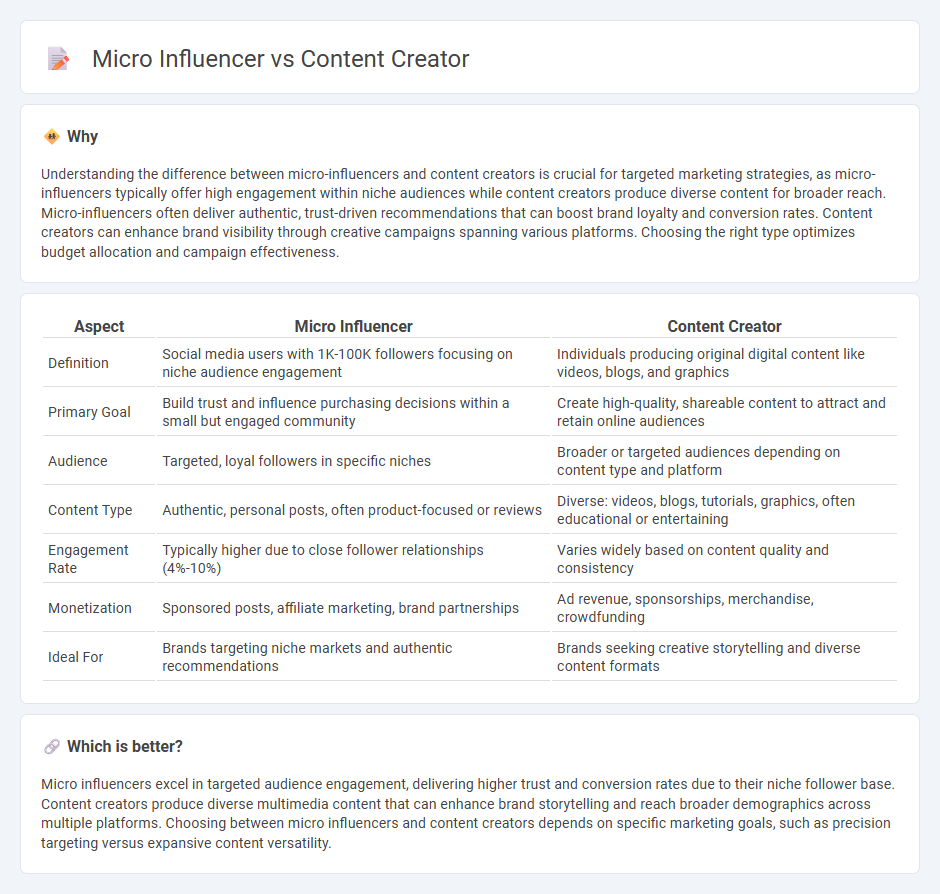
Micro influencers engage niche audiences with authentic, targeted content, driving higher engagement rates and trust compared to broader content creators. Content creators produce diverse digital materials across platforms, often focusing on volume and variety rather than personalized influence. Explore the nuances between these two marketing strategies to optimize your brand's reach and impact.
Why it is important
Understanding the difference between micro-influencers and content creators is crucial for targeted marketing strategies, as micro-influencers typically offer high engagement within niche audiences while content creators produce diverse content for broader reach. Micro-influencers often deliver authentic, trust-driven recommendations that can boost brand loyalty and conversion rates. Content creators can enhance brand visibility through creative campaigns spanning various platforms. Choosing the right type optimizes budget allocation and campaign effectiveness.
Comparison Table
| Aspect | Micro Influencer | Content Creator |
|---|---|---|
| Definition | Social media users with 1K-100K followers focusing on niche audience engagement | Individuals producing original digital content like videos, blogs, and graphics |
| Primary Goal | Build trust and influence purchasing decisions within a small but engaged community | Create high-quality, shareable content to attract and retain online audiences |
| Audience | Targeted, loyal followers in specific niches | Broader or targeted audiences depending on content type and platform |
| Content Type | Authentic, personal posts, often product-focused or reviews | Diverse: videos, blogs, tutorials, graphics, often educational or entertaining |
| Engagement Rate | Typically higher due to close follower relationships (4%-10%) | Varies widely based on content quality and consistency |
| Monetization | Sponsored posts, affiliate marketing, brand partnerships | Ad revenue, sponsorships, merchandise, crowdfunding |
| Ideal For | Brands targeting niche markets and authentic recommendations | Brands seeking creative storytelling and diverse content formats |
Which is better?
Micro influencers excel in targeted audience engagement, delivering higher trust and conversion rates due to their niche follower base. Content creators produce diverse multimedia content that can enhance brand storytelling and reach broader demographics across multiple platforms. Choosing between micro influencers and content creators depends on specific marketing goals, such as precision targeting versus expansive content versatility.
Connection
Micro-influencers and content creators are closely connected through their shared focus on authentic and engaging content tailored to niche audiences, enhancing brand trust and reach. Micro-influencers often act as content creators by producing original posts, videos, and stories that resonate with their followers, driving higher engagement rates compared to traditional influencers. Brands leverage this synergy to implement targeted marketing strategies that boost conversion rates and foster community-driven brand loyalty.
Key Terms
Audience Engagement
Content creators develop original, high-quality material tailored to niche audiences, fostering deep connections through consistent storytelling and creativity. Micro-influencers, with follower counts typically between 1,000 to 100,000, excel in authentic engagement by leveraging trust and relatability within their communities. Explore the unique strategies each employs to maximize audience interaction and brand impact.
Brand Collaboration
Brand collaboration with content creators often results in diverse and high-quality multimedia assets due to their professional production skills and broad audience reach. Micro influencers tend to offer niche audience engagement and higher authenticity, leading to stronger customer trust and conversion rates in targeted campaigns. Explore how aligning your brand with either content creators or micro influencers can maximize marketing impact.
Content Authenticity
Content creators prioritize producing unique, high-quality material tailored to their specific audience, often showcasing creativity and expertise. Micro influencers emphasize authentic engagement and trust within a smaller, niche community, making their recommendations highly credible. Explore the distinct advantages of each role to maximize your brand's impact and authenticity.
Source and External Links
How to Become a Content Creator: Steps, Tips, and Industry Truths - A content creator is someone who consistently produces content on specific topics for particular audiences, such as podcasters, vloggers, bloggers, UGC creators, and social media influencers, focusing on digital platforms and monetizing through sponsorships and collaborations.
What is a content creator and how to become one? - Adobe - Content creators produce entertaining or educational digital material across various media channels, often for social media, aiming to engage audiences and potentially earn income via influencer marketing and other content monetization methods.
Content creation - Wikipedia - Content creation involves producing and sharing information or media, especially in digital contexts, including activities like blogging, videography, social media management, and content editing, with a focus on reaching specific online audiences.
 dowidth.com
dowidth.com